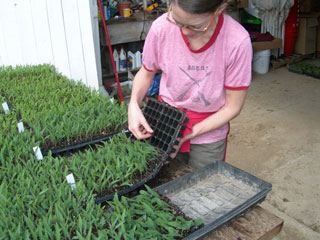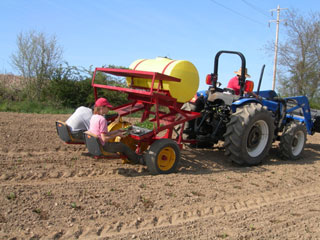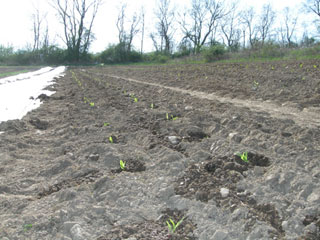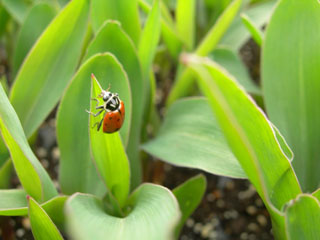In my graduating high school class, I was voted "least
likely to become a farmer." Actually, they voted me "most likely to
become a knucklehead farmer." Some of my classmates, honest to God, they
could take a rusty ole manure spreader that had been sitting outside, unused
for five years, and whip it into shape. For a pittance, they'd get it up and
running. There was one whose hat always smelled like skunk because after he
milked cows at the crack of dawn, he checked on all his traps before catching
the bus to school. I, on the other hand, was lucky if I got my teeth brushed in
time to make the bus. And neither my parents nor my grandparents had ever
farmed. Put it this way: I was also in the running for "most likely to
pour anti-freeze into the fuel tank of a tractor." OK, OK. There were no
such categories at Kutztown High. But my classmates, many of them farmkids,
definitely did not elect me "most likely to succeed." And so, as if
not to disappoint, I eventually became a farmer and I developed my own peculiar
corn-planting technique. It's called "start the little corns in the
greenhouse and then transplant them outside so they get a head start on the
weeds as well as the multitudinous insects and worms that stand between the
farmer and a presentable ear of corn. Although there is a small but growing
class of customer famous for peeling open an ear of unpurchased corn and
observing, "Aw, look at the cute little European Corn Borer," the
majority response is still "Eeew! A worm!" So here is Beth pulling
corn seedlings out of greenhouse plug trays:

Although I used to transplant the corn by hand, this year
I've taken advantage of technology. If I could only drive the tractor in a
straight line. 

And here are the transplanted corns, awaiting white protective row coverings like those to the left of them, shivering but way ahead of the competition. The trees have not even begun to leaf out.
Because of all the pests that corn tends to attract, most organic farmers steer clear of it. I once talked to a guy who flew crop duster planes over large fields of southern sweet corn in the summer. To effectively disrupt the reproductive cycles of all the different pests, he sometimes flew over those fields every other day. The pesticides he used killed both the good bugs and the bad. (Good bugs are the carnivores that eat the vegetarian "bad bugs" that eat our crops.) As a farmer who does not use any pesticides or herbicides, I prefer a laissez-faire approach: let the good bugs and bad bugs have at it, but give the corn a head start. The Ladybug Benevolent Society wholeheartedly endorses my corn growing technique.

It took four people the better part of a day to plant an acre and a half of corn and then cover it against the chilly spring. Another day will be devoted to hoeing and rototilling the weeds that grow along with the corn. A single conventionally equipped farmer could plant an acre and a half in ten minutes and then go home and read a few chapters of War and Peace before we've finished getting the corn seedlings out of the plug trays. And still, we get some worms… Only a knucklehead would transplant corn like it was a geranium. Few of those resourceful young tractor-fixing whizzes are farmers today. The guy who trapped skunks is an exception. Mike owns three farms and plants a couple hundred acres of field corn every year, using the War and Peace method. Mike is one of the best farmers I know. And he keeps himself busy. His grandchildren are only a few years younger than my daughters. And he has the biggest hay bail throwing hands you could ever imagine. One of these days I'm going to go over to Mike's farm just to take a picture of his hands so you can see what it takes to be a real farmer. (Thanks to Wayne Miller for the photos and to Wayne, Beth Duby, and Eric de Jesus for abetting a knucklehead.)

